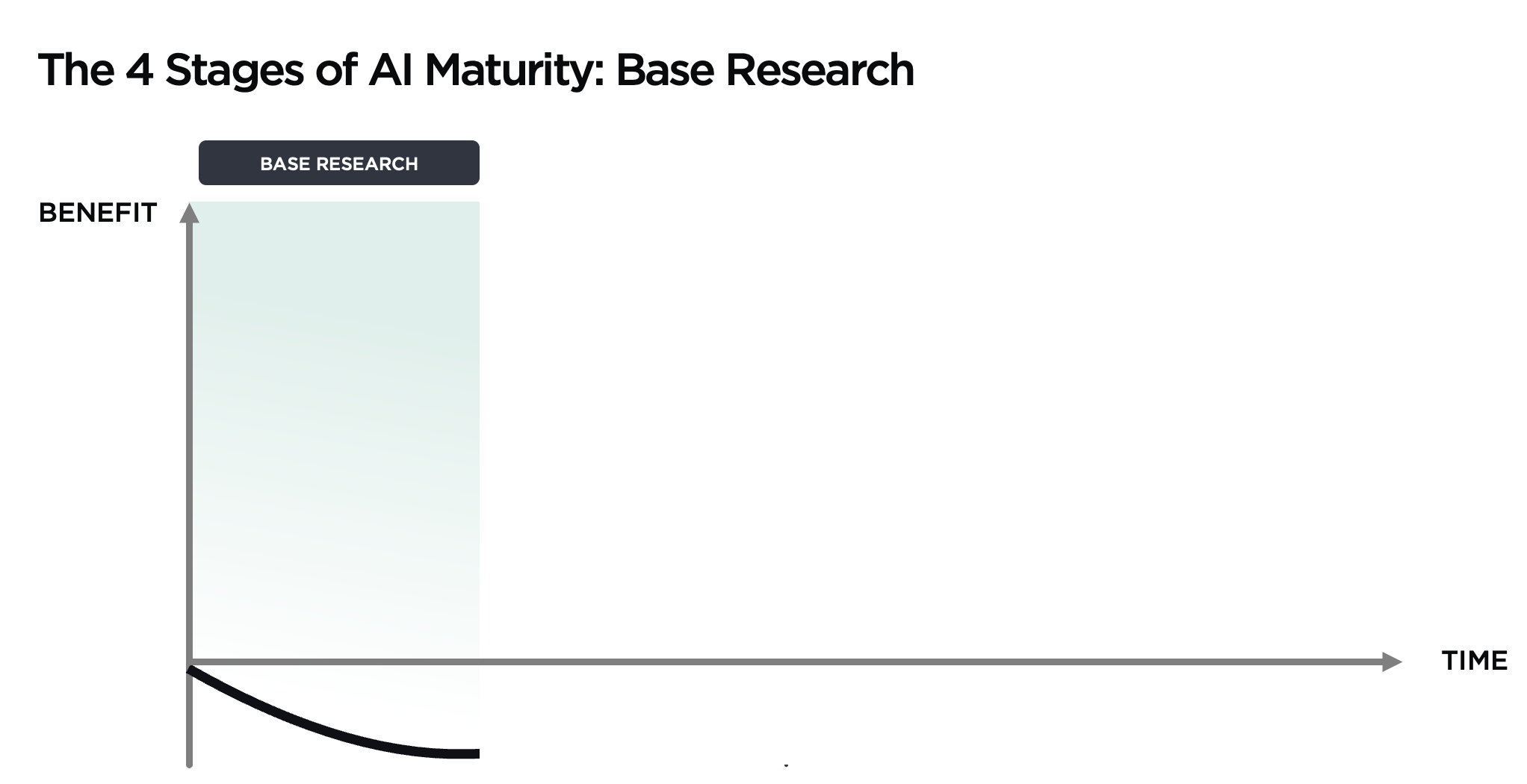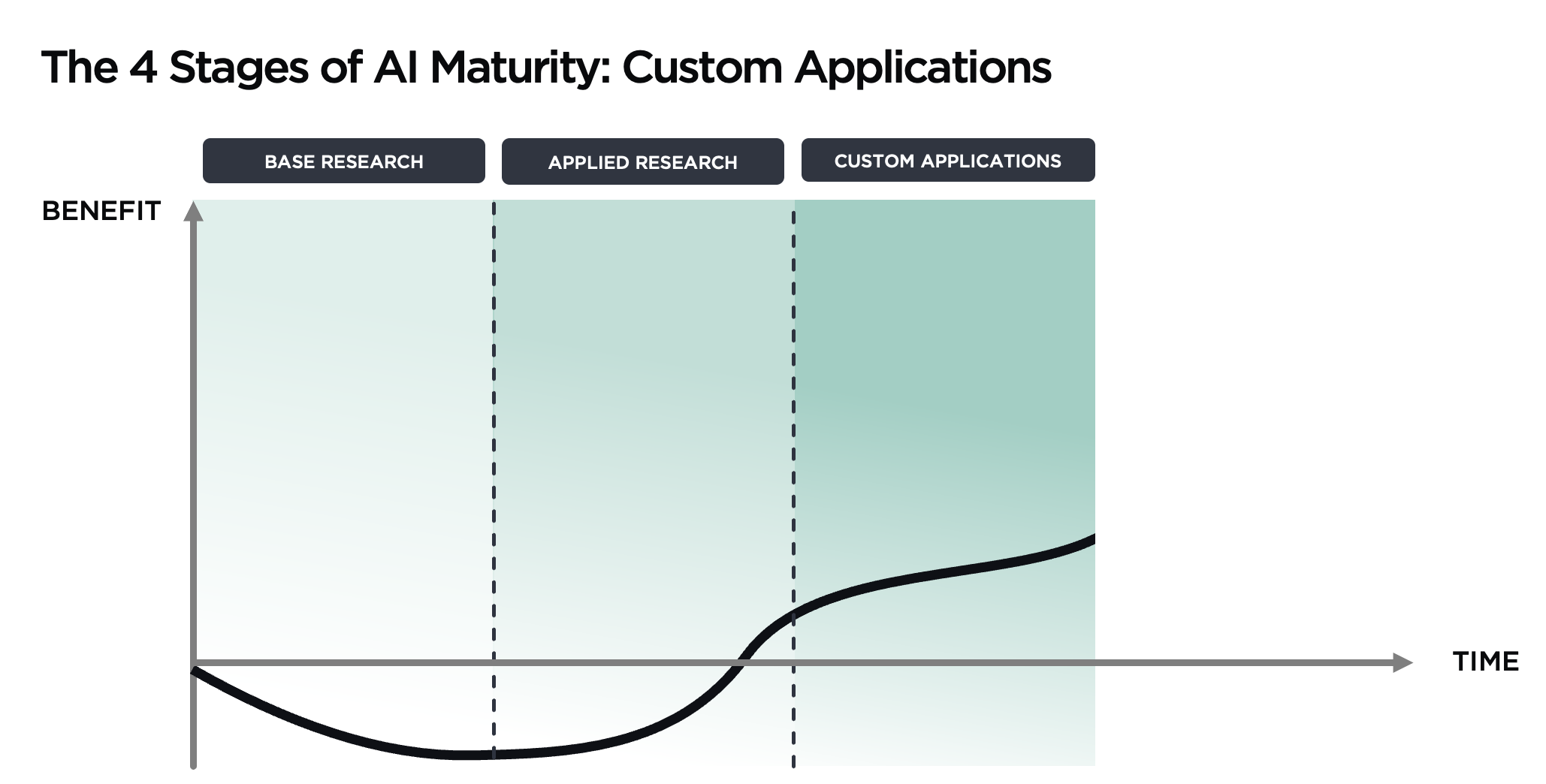Over the past few years, the adoption of AI into institutional investors’ investment processes has proved to be successful in increasing investment results and operational efficiency. The remarkable application of such technology in this field has then grabbed substantial attention, particularly from large financial institutions, to the point that Forrester – the world’s leading strategic consultancy firm – estimates that by 2025 an estimated $64 billion will be spent by large organizations to buy AI softwares and platforms.
In this article, we will delve into each stage of our AI maturity model, shedding light on the journey from Base Research to the actual Integration. To illustrate our research, we will also draw upon Gartner’s AI maturity model, which segments companies into five levels of maturity regarding their use of AI.
From Research to Integration: AI’s Impact on Investments
The journey from Research to Integration begins with a foundational understanding, progresses through experimentation and customization, and culminates in full integration. As also Gartner’s AI maturity model illustrates, the path to AI maturity is not linear, and companies may find themselves at different levels for various aspects of their operations. However, it is essential to recognize that, despite the initial challenges and costs, the benefits of AI integration in the world of investment are substantial. As AI continues to evolve and mature, there will be even greater advancements and opportunities in the financial industry, solidifying AI’s place as a cornerstone of modern investment practices.
Base Research – Laying the Foundation for AI

In the early stages of AI integration, companies find themselves in what Gartner refers to as Level 1 – Awareness. At this juncture, organizations are aware of AI’s potential but have not yet harnessed its power. They may be enthusiastic about implementing AI but lack a concrete strategy for doing so. It is a period characterized by ideation and the formulation of AI concepts.
This phase refers to the Base Research stage. It is where the groundwork is laid, where we invest in understanding the AI landscape, its capabilities, and limitations. The benefits may be elusive at this point, as the costs of research and analysis often outweigh the initial gains. However, this investment is essential to building a solid AI foundation.
Applied Research – Experimentation and Learning

As companies progress to what Gartner calls Level 2 – Active, they begin to experiment with AI informally. They start experimenting with AI in practical settings. This phase aligns with our Applied Research stage. Here, we take our understanding from the Base Research stage and put it into action. In this phase, AI may still be in its infancy, but we start to see practical applications taking shape. While the benefits may not be huge yet, the insights gained through experimentation are invaluable. It’s a period of learning and fine-tuning.
Custom Applications – Harnessing AI for Specific Needs

At Gartner’s Model Level 3 – Operational, companies have adopted machine learning into their daily functions. They have dedicated teams of ML engineers, infrastructure in place, and are actively using AI for information processing tasks. This stage corresponds to our Custom Applications phase, where we understand that it’s essential not only to embrace AI but also to tailor the solution to our clients’ specific needs.
In this stage, AI is harnessed for specific investment requirements, ensuring that the solutions we develop align precisely with our clients’ objectives. This may encompass activities such as portfolio optimization, risk assessment, or market trend analysis. The benefits of AI deployment in this phase progressively outweigh the associated costs, and AI begins to deliver tangible and highly customized value to our clients.
Integration – AI as an Integral Part of Investments

Finally, at what Gartner calls Level 4 – Systemic, companies are using AI in novel ways to enhance traditional business models. They have fully integrated AI into their processes and infrastructure. This aligns with what we call the Integration phase.
In the Integration phase, AI becomes an integral part of investment processes. It’s not just a tool; it’s the backbone of decision-making. At this pinnacle of AI maturity, institutional investors harness AI in innovative ways that have the potential to enhance and improve traditional business models. The difference between merely being aware of AI (Level 1) and achieving systemic integration (Level 4) is profound. It’s not just about enthusiasm; it’s about having the infrastructure and expertise to leverage AI to its fullest potential.
By entering this last phase, investors are not just keeping pace with the times but are actively shaping the future. The potential for enhanced precision, client-centric solutions, and a competitive edge makes the Integration phase a strategic priority for all institutional investors as they navigate the evolving landscape of investments.
Open Innovation Partnerships, a True Growth Driver for Financial Institutions
However, to do this effectively, finding the right Fintech partner is paramount. The right partner can provide the expertise, technology, and support needed to fully harness the potential of AI, ensuring that institutional investors not only adapt to the AI-driven future but really thrive in it.
Open Innovation partnerships provide access to new ideas, expertise, and resources, and help businesses stay competitive and drive growth in an increasingly complex and fast-paced market. Sharing knowledge and resources, as well as encouraging the development of innovative solutions to complex problems, are the main drivers of outsourcing partnerships.
As diverse AI platforms and tools continue to be developed, it is crucial to possess a comprehensive understanding of how these technologies can be effectively integrated to prevent falling behind during this rapid transitional period.
Furthermore, the alliances between Fintechs and Financial Institutions have proved to be extremely valuable to integrate AI to support the tactical and strategic Asset Allocation process in an efficient way. Especially in an extremely competitive and rapidly evolving context such as the current one, this allows for accelerated business and corporate profitability thanks to greater efficiency of processes, and significantly reduced development times to bring new products and services to market.
And if it is true that technological progress today makes it possible to adapt portfolio choices, Asset Allocation, and risk management to the gradual evolution of the markets, it is also true that this is a step forward from which we will not go back.
- SEO Powered Content & PR Distribution. Get Amplified Today.
- PlatoData.Network Vertical Generative Ai. Empower Yourself. Access Here.
- PlatoAiStream. Web3 Intelligence. Knowledge Amplified. Access Here.
- PlatoESG. Carbon, CleanTech, Energy, Environment, Solar, Waste Management. Access Here.
- PlatoHealth. Biotech and Clinical Trials Intelligence. Access Here.
- Source: https://www.finextra.com/blogposting/25164/the-four-stages-of-ai-maturity-from-base-research-to-successful-integration-in-investments?utm_medium=rssfinextra&utm_source=finextrablogs
- :has
- :is
- :not
- :where
- 1
- 20
- 2025
- 26
- 27
- 30
- 31
- 35%
- a
- About
- accelerated
- access
- achieving
- Action
- active
- actively
- activities
- actual
- adapt
- adopted
- Adoption
- advancements
- AI
- AI Integration
- align
- Aligns
- All
- Alliances
- allocation
- allows
- also
- an
- analysis
- and
- and infrastructure
- Application
- applications
- applied
- ARE
- article
- AS
- aspects
- assessment
- asset
- asset allocation
- associated
- At
- attention
- aware
- awareness
- back
- Backbone
- base
- BE
- becomes
- begin
- behind
- being
- benefits
- between
- Billion
- bring
- business
- business models
- businesses
- but
- buy
- by
- call
- Calls
- CAN
- capabilities
- challenges
- characterized
- choices
- client-centric
- clients
- Companies
- competitive
- complex
- comprehensive
- concepts
- consultancy
- context
- continue
- continues
- cornerstone
- Corporate
- corresponds
- Costs
- crucial
- Current
- custom
- customization
- customized
- daily
- Decision Making
- dedicated
- deliver
- delve
- deployment
- Despite
- develop
- developed
- Development
- difference
- different
- diverse
- do
- doing
- draw
- drive
- driver
- drivers
- during
- each
- Early
- Edge
- effectively
- efficiency
- efficient
- embrace
- encompass
- encouraging
- Engineers
- enhance
- enhanced
- ensuring
- entering
- enthusiasm
- enthusiastic
- especially
- essential
- estimated
- estimates
- Even
- evolution
- evolve
- evolving
- experiment
- expertise
- extremely
- Falling
- fast-paced
- few
- field
- financial
- Financial institutions
- Find
- finding
- fintech
- fintechs
- Firm
- five
- For
- formulation
- Forrester
- Forward
- Foundation
- four
- from
- full
- fully
- functions
- future
- gained
- Gains
- Gartner
- Go
- gradual
- greater
- groundwork
- Growth
- harness
- Harnessing
- Have
- having
- help
- here
- highly
- How
- However
- HTTPS
- huge
- ideas
- ideation
- if
- illustrate
- illustrates
- Impact
- implementing
- improve
- in
- increasing
- increasingly
- industry
- information
- Infrastructure
- initial
- Innovation
- innovative
- insights
- Institutional
- institutional investors
- institutions
- integral
- integrate
- integrated
- integration
- into
- invaluable
- Invest
- investment
- Investments
- Investors
- IT
- ITS
- journey
- just
- keeping
- knowledge
- Lack
- landscape
- large
- Last
- leading
- learning
- Level
- level 4
- levels
- Leverage
- light
- limitations
- machine
- machine learning
- Main
- MAKES
- management
- Market
- Markets
- mature
- maturity
- Maturity Model
- May..
- merely
- ML
- model
- models
- Modern
- Navigate
- needed
- needs
- New
- new products
- novel
- objectives
- of
- often
- on
- ONE
- only
- operational
- Operations
- opportunities
- optimization
- or
- organizations
- our
- Outsourcing
- outweigh
- Pace
- Paramount
- part
- particularly
- partner
- partnerships
- past
- path
- period
- phase
- pinnacle
- Place
- Platforms
- plato
- Plato Data Intelligence
- PlatoData
- Point
- portfolio
- possess
- possible
- potential
- power
- Practical
- Practical Applications
- practices
- precisely
- Precision
- prevent
- problems
- process
- processes
- processing
- Products
- Products and Services
- profound
- Progress
- proved
- provide
- put
- rapid
- rapidly
- really
- recognize
- Reduced
- refers
- regarding
- remarkable
- Requirements
- research
- Resources
- right
- Risk
- risk assessment
- risk management
- s
- segments
- Services
- settings
- Shape
- shaping
- sharing
- significantly
- So
- solid
- solidifying
- solution
- Solutions
- specific
- spent
- Stage
- stages
- start
- stay
- Step
- Still
- Strategic
- Strategy
- substantial
- successful
- such
- support
- systemic
- tactical
- Take
- taking
- tangible
- tasks
- teams
- technological
- Technologies
- Technology
- thanks
- that
- The
- The Future
- the world
- their
- themselves
- then
- There.
- These
- they
- this
- Thrive
- Through
- times
- to
- today
- tool
- tools
- traditional
- Trend
- trend analysis
- true
- understand
- understanding
- use
- using
- Valuable
- value
- various
- Way..
- ways
- we
- WELL
- What
- which
- while
- will
- with
- world
- years
- yet
- zephyrnet












